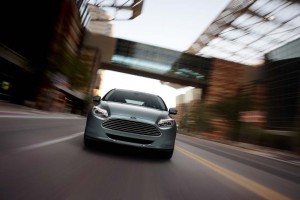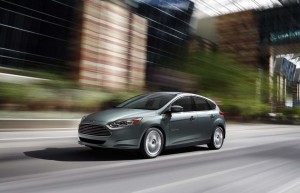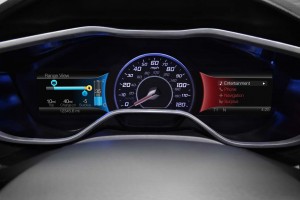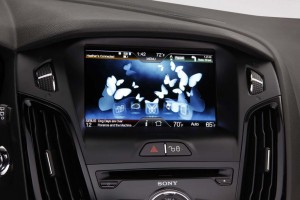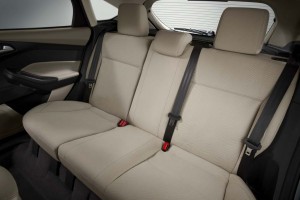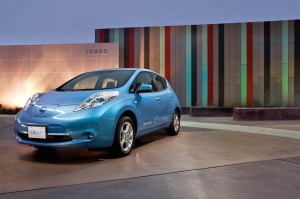This is the year of the electric vehicle, or so proponents would like to believe, as a wave of battery cars make their debut and the first actually roll into showrooms. Following last month’s debut of the low-volume Transit Connect Electric delivery van, Ford Motor Co. is rolling out what it hopes will be a more mainstream offering: a battery-powered version of its newly-redesigned compact hatchback, dubbed the Ford Focus Electric.
With an estimated range of 100 miles per charge, Ford’s offering won’t reach market until 2012, well behind the introductions of the Nissan Leaf battery-electric vehicle, or BEV, and the Chevrolet Volt plug-in hybrid. But what the Focus Electric loses by not having first-mover advantage Ford is hoping to more than make up for by offering a wealth of features on its first battery-based passenger car.
 The Ford Focus Electric is visually similar to the gas-powered compact, which is offered in both sedan and hatchback configurations. But there will be a number of changes designed to improve its efficiency, critical when trying to maximize battery power. That includes a revised grille, an enclosed underbody and special wheels meant to improve aerodynamics, as well as low rolling-resistance tires.
The Ford Focus Electric is visually similar to the gas-powered compact, which is offered in both sedan and hatchback configurations. But there will be a number of changes designed to improve its efficiency, critical when trying to maximize battery power. That includes a revised grille, an enclosed underbody and special wheels meant to improve aerodynamics, as well as low rolling-resistance tires.
Meanwhile, an LED “light ring” will surround the electric charger port – repurposed from the fuel filler door on a conventional Focus. Soft blue lights will flash to indicate the Focus Electric is charging and then to signal the battery has been topped off.
Ford engineers took other, less visible steps to improve range. For one thing, they set a top speed of just 84 mph as range falls sharply at higher speeds. But company officials don’t believe that will have much of an impact on the sort of customer interested in a vehicle like Focus Electric.
Such customers “are not buying a car,” suggest Sherif Marakby, who heads Ford’s electrification program. “They are buying a philosophy.”
Like Leaf, Volt and perhaps two dozen more advanced battery vehicles coming to market by mid-decade, the 2012 Ford Focus Electric offers a number of both advantages and disadvantages when compared to conventional vehicles. On the plus side: the battery vehicle produces absolutely no emissions (unless you take into account the power plant producing its electricity); it’s distinctly quieter than a conventional automobile; and it is expected to cost no more than a couple cents a mile for energy, barely a fifth as much as it would cost running on gasoline.
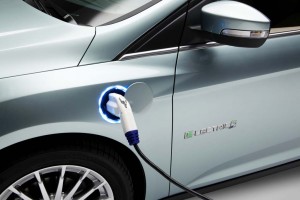
A light ring around the charger port offers a quick visual indication of whether the batteries are ready.
The downside includes an anticipated price premium likely to run into the thousands of dollars, even considering a $7,500 federal tax credit; the limited range of the Ford Focus Electric’s 23 kilowatt-hours of lithium-ion batteries; and the long charging time needed to get it back on the road.
But Ford plans to introduce a new, 220-volt charger that it claims will cut charging times to barely 3 hours, about half that of the Nissan Leaf using a similar Level II charger.
In a significant move, Ford plans to make the $1,499 charger available through the nationwide Best Buy chain. The charger will use an industry-standard plug, however, and could be used with the Leaf, the Volt and other battery cars to come. The Ford system also will make it easy to disconnect and relocate the charger should the owner move or sell the vehicle.
The Focus Electric will also allow a motorist to recharge using a conventional 110-volt outlet, but that would normally be an emergency-only option considering such a move would require as much as 20 hours to fully recharge the 550 pounds of batteries tucked beneath the rear seat of the vehicle.
Precise range information likely won’t be released until closer to the time the Ford Focus Electric actually rolls into showrooms. As Nissan discovered, the final, official figure could fall below the 100-mile mark reflecting a multi-procedure process newly implemented by the Environmental Protection Agency, which regulates fuel economy – and the information an automaker must publish on the so-called Munroney sticker pasted onto the side window of all new cars.
Efficiency is subject to a variety of factors, including driver behavior, road conditions and even the weather. During a cold day in Michigan, with traffic at a crawl, range could conceivably be cut by half.
To help a motorist figure out what to expect, the Ford Focus Electric will be equipped with a revised version of the SmartGauge system used in the maker’s current gas-electric models, such as the Escape Hybrid. The system will not just display information on how much range is left but even coach a motorist to improve their driving efficiency.
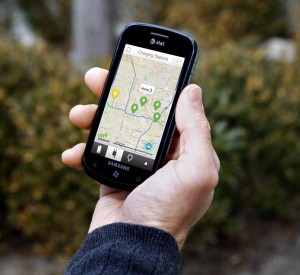
A touch of the MyFordMobile app will give Focus Electric owners the ability to set charging times, pre-heat the cabin and more.
The video monitor atop the center console will provide additional information, even displaying butterflies to show when a motorist’s driving behavior is particularly efficient. (The Nissan Leaf, meanwhile, shows little pine tree icons growing atop the instrument panel to reward drivers who drive carefully.)
Among other things, Focus Electric drivers will be able to see how far they can get before running down the battery pack – as well as where charging stations will be available along the way.
Currently, there are just 1,800 public Level II charging facilities located across the country, according to Mike Tinskey, who oversees electric infrastructure issues for Ford, but that is expect to reach 12,000 not long after the new model hits showrooms. Further out, the industry is hoping to see adoption of the Level III charging system, which could provide an 80% electric “refill” in as little as 20 to 30 minutes. Right now, however, there is only one such public facility in the U.S., located in Portland, Oregon. (For more on battery car Quick Charging, Click Here.)
To further enhance the appeal of the Focus Electric, Ford is introducing a new smartphone app and service dubbed MyFordMobile. The system – which will be offered free to battery car buyers for the first five years of ownership – permits an owner to handle a variety of services remotely.
That includes setting up a charging schedule that takes advantage of the lowest possible electric rates offered by the local utility. (Many electric providers plan to offer reduced off-peak rates to encourage battery car adoption.) The app will let a driver pre-heat the Focus Electric’s cabin while the vehicle is still connected to its charger, reducing battery drain. MyFordMobile users will even be able to search for a restaurant or store and see if it can be reached based on the battery’s current charge state.
(For more on MyFordMobile Click Here.)
In an unusual move, Ford officials chose to launch both the Focus Electric and MyFordMobile at the annual Consumer Electronics Show, in Las Vegas, rather than next week’s Detroit Auto Show. But that reflects the fact that, “Ford is not just a car company. We’re a technology company,” explained Derrick Kuzak, Ford’s global product development chief, during a media background session.
The new offering will also be on display at the North American International Auto Show, next week.

